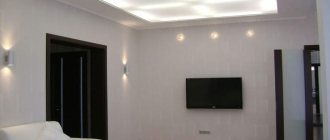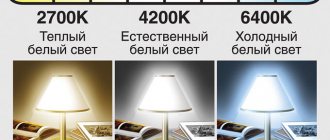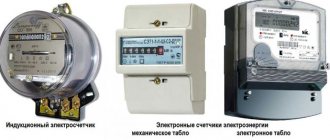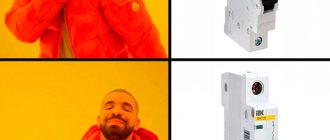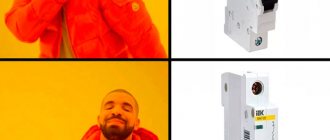But if you still need to control the brightness of LED lighting, how do you usually choose such lamps and dimmer luminaires?
First of all, we look at the packaging. It must have a special dimmable icon on it.
Such lamps will cost a little more than conventional LED lamps. In conventional ones, the driver compensates for voltage fluctuations to the optimal operating current.
Therefore, if you connect a simple LED lamp to a dimmer, it will still shine with constant brightness, no matter how you twist the knob. In extreme cases, the light will start blinking.
No matter what sophisticated and modern dimmer you buy, you will not be able to correct the situation. Although there are rare exceptions.
Operating principle and design
Rotary dimmer for LED lamps
A dimmer is an element that allows you to smoothly change the intensity of artificial lighting, turn light bulbs on and off, and control light remotely. The adjustment is carried out by changing the voltage and, accordingly, the power of the device. This can be done by adding a load - ballast resistors, capacitors, chokes. In LED lamps, adjustment is made using dimmers.
Not every LED light source can be connected to a dimmer. To achieve stable lighting control, you need special controllers or devices with a PWM function. It is important to choose the right regulator for the light bulb, since the quality of the lighting change will depend on its circuitry.
The dimmer operates like a rheostat. Voltage or current changes as a result of changes in resistance. Nowadays, semiconductor regulators are actively used - triacs and dinistors, operating on the PWM principle.
The advantages of dimmers include:
- creating comfortable lighting at any time of the day;
- energy saving;
- reliability;
- smooth start;
- you can control several lamps;
- increasing the service life of lighting devices;
- ease of installation;
- possibility of synchronization with the “smart home” system;
- creating unique visual effects.
Saving electricity is the most important advantage of dimmable devices over conventional light sources. By adjusting the light level, the lamp will not burn at full power all the time and, accordingly, consume a large amount of electricity. This use also leads to an increase in the service life of the lamp.
12 V light dimmer
Disadvantages:
- high price;
- incorrect choice of regulator can lead to malfunctions;
- cheap devices can cause interference;
- sensitivity to elevated temperatures;
- low efficiency in night mode.
Regulators for 220 V and 12 V have design differences. The simplest mechanisms that craftsmen can make at home perform the function of changing the intensity of light. Modern models have wider functionality - for example, the “Sleep” function, in which the brightness is maintained at 30% of full. There is also a “good morning” function when the intensity increases, or a “good night” function when the light becomes more subdued.
Light controllers are used in different areas. In home lighting, in billboards, for entertainment purposes. Adjustable lamps are used in office lamps VG SKUL 1200-36 W.
Dimmers are an important component of the smart home system. An important function of the regulators is the emergency lighting system. When operating from a battery or battery, the service life increases by reducing the brightness.
Functions
In addition to the main function of adjusting the brightness of the light flux, there are a number of additional options, which include the following:
- the ability to automatically turn off the lamp;
- the presence of a simulating function that creates the feeling of a person’s presence in the house;
- smooth switching on or off of the lamp;
- use of several dimming modes;
- possibility of remote control;
- endurance of the device and the ability to operate it under the influence of any temperature conditions in the room.
Types of dimmers
Touch-sensitive light controller
Classification of controllers is made according to various criteria: type of voltage in the circuit, type of control signal, installation method, design.
Based on the network voltage, light controllers can be divided into two groups:
- for alternating voltage 220 V;
- for constant voltage on LED strip 12 V.
Based on the type of control signal, dimmers for LEDs are distinguished:
- analog;
- digital;
- digital-analog.
Monoblock key dimmer
There are several types based on the installation method:
- modular, which are mounted on a special DIN rail in the distribution panel;
- remote ones, which are mounted in a chandelier;
- wall-mounted, which are installed instead of a switch.
By control method:
- rotary - adjustment is carried out using a handle;
- keyboards – control is performed using buttons;
- rotary-push - adjustment is made by pressing buttons and turning the knob;
- touch – models with various sensors;
- remote – controlled by remote control via Wi-Fi, radio or infrared.
The most expensive are touch-sensitive light controllers. These are modern devices that can be controlled by voice commands, movements, or clapping.
Where are dimmable LED lamps used?
The scope of application is wide. See for yourself:
- Premises where people live. This area of application comes first because the lighting parameter is important to everyone. Some people use such lamps for outdoor lighting, which pleases the eyes of household members at dusk.
- To ensure the proper level of illumination in the enterprise. If we are talking about a place where work is being done on the manufacture of small parts, then adjusting the light is simply necessary. This also includes lighting in cafes and restaurants. In the latter, they create a particular atmosphere, thereby attracting visitors.
Criterias of choice
What dimmable LED lamps look like
LED light sources can be dimmable or non-dimmable. This must be taken into account when purchasing. Regulators should be selected taking into account the following aspects:
- Possibility of adjusting the light source. You cannot install a dimmer on an unregulated LED lamp. This will cause damage that is not covered under warranty.
- The number of light sources that the dimmer will control. For one light bulb, it is enough to purchase a low voltage regulator.
- Light bulb power and minimum dimmer load level. For most regulators, the minimum load is 20-45 watts. This power can be achieved using 2-3 LED lamps connected to a 220 V network.
- Total load on devices. The dimmer power should exceed approximately 30% the total connected load.
- Voltage. For lamps you need a dimmer that works with a 220 V network, and for strips - for 12 V or any PWM regulator.
When choosing a regulator, you should give preference to proven, well-known brands. These include Schneider Electric, Legrand, Makel, ABB and others. A low-quality product of unknown origin can lead to lamp failure. You also need to buy devices from specialized stores. There the seller will help you choose a dimmer, give advice on connection and tell you about the warranty conditions.
Changing color temperature
At maximum power, the light bulb will shine as expected, according to its characteristics. But when you dim and reduce the brightness, you will get a completely different light than you expected.
The fact is that the color temperature of an incandescent lamp changes significantly when dimming. And with your vision, willingly or unwillingly, you notice it.
It does not remain constant at all around 2700K, but goes to the limit of 1500K. And only at maximum heat will the same 2700K be produced.
Moreover, if an increased voltage of more than 220V (240-250V) is supplied to the light bulb, then it will not produce this same 2700K at maximum.
But LEDs cannot repeat this “trick”. Whether this is a disadvantage or an advantage is difficult to say. But the fact remains a fact.
When the brightness is reduced, LED lamps shine differently than we are used to. And you will feel it with your vision. There won’t be that same “lampiness” and comfort.
It turns out that even when the dimmer is turned to the very minimum, the light emitted in them is the same temperature as stated on the packaging or case.
If it is indicated that the color temperature of a given specimen is 2700K, then it will remain so. It doesn't matter what dimmer you connect to it.
Visually the difference is very strong. The light turns out whiter. Here's a good example.
One chandelier simultaneously contains simple incandescent light bulbs (on the right) and one LED light bulb (on the left). All have the same temperature and equivalent power. This is how the chandelier glows at maximum.
As you can see, there is practically no difference. And so, this same chandelier glows at the lowest dimmer setting. The result, as they say, is obvious.
This will be especially noticeable if you use a dimmer to turn a simple lamp into a night light. In this case, it is better not to save money and choose real night lamps that provide complete, dim and comfortable light in the bedroom.
In order to somehow influence the situation, LED lamps with a temperature of 2000K have recently begun to be mass-produced. Some manufacturers even give the glass bulb an orange tint.
All this is precisely connected with an attempt to achieve maximum similarity with the good old incandescent light bulbs that we love so much.
Even most vintage LED lamps, which simulate an incandescent filament inside, also come with this temperature.
Light control method
A dimmer with a leading edge phase cutoff contains a triac, a diac and an RC circuit.
AC dimmers differ not only in design, but also in the method of adjustment. These include:
- dimmer with leading edge cutoff;
- with trailing edge cut-off.
The first ones are the cheapest and simplest devices. The remainder of the half-wave is applied to the load, its first half is cut off. When turned on, noise occurs that may interfere with the operation of household devices. Such dimmers are used for special LED lamps. You can tell if a light bulb is suitable by looking at the labels on the packaging.
The second type is suitable for a larger number of lamps and works without interference. The adjustment is carried out better, but within a certain range, not from scratch.
Lamps with built-in brightness control are placed in a separate group. They include an LED matrix, a driver, a bulb and the regulator itself. There is no need to install additional dimmers for such lighting devices.
How does regulation happen?
Any dimmer is a device that is built in according to the principle of a traditional switch, familiar to all users, or instead of it.
The main condition is that it should be located before the LED lamp power driver, although in some cases this is no longer a mandatory parameter, but such a pleasure is expensive.
To a person unfamiliar with a dimmer, it may seem that it simply changes the voltage, as conventional regulators do, but this is not the case. The design of dimmable LED lamps is complex; the principle of their operation is somewhat different from the usual devices that illuminated the room with incandescent lamps.
Regardless of design and size, all mechanical regulators perform only the simplest functions, such as turning on/off, changing brightness
Since all LEDs operate in a narrow voltage range, even a slight decrease in voltage will cause the lighting fixtures to flicker, go out, or not turn on at all.
To avoid this, dimmers make adjustments based not on the traditional principle of reducing the load supplied to the lamp, but on the use of pole-width modulation. With the help of which electric current is supplied in short pulses with relatively long pauses between them.
The described procedure is performed up to hundreds of times every second. Thus, any LED lamp can be made to stably illuminate the room at 10-100% of its capabilities.
Self-installation of the regulator
Connection diagram for a dimmer to LED lamps
You can install a dimmer for 220 V LED lamps yourself. The master must have minimal knowledge in the field of electrical appliances and follow safety precautions.
Step-by-step installation algorithm:
- Power outage in the house. Checking the presence of voltage using an indicator.
- Studying the dimmer circuit.
- Loosening the bolts, installing the regulator contacts into the circuit connectors. It is important not to mix up the wires and follow their markings. Typically white is the phase and blue is connected to the load.
- Tighten the bolts after installation to ensure good contact.
- Installing a dimmer in a socket box.
- Installation of the protective housing and button.
Afterwards, you can turn on the electricity and test the assembled system. By the smooth change in the backlight, you can judge that the assembly was carried out correctly.
Installation may vary slightly for different types of dimmers and devices from different companies. Be sure to read the instructions included with the kit.
What is dimming?
Any electrical appliance only works if there is some kind of load, and it can be controlled. The regulation process itself is called dimming. This can also be done with LED lamps.
This procedure is performed with a device called a “dimmer”. It is this that can provide additional energy savings.
Modern dimmers differ in performance, size, and can solve various problems of saving energy, increasing comfort in the home, and even scaring off criminals
In addition, the presented device significantly expands the functionality of LED lamps. Which is also a significant plus.
Possible installation errors
Installing a dimmer is not difficult, but beginners can make a number of mistakes. Typical problems include:
- using a dimmer at elevated temperatures - the optimal maximum temperature is 27-30 degrees;
- the load must be at least 40-45 V, otherwise the service life of the dimmer and lamp will decrease;
- incorrect choice of dimmer for a specific light bulb;
- using a regulator for an LED strip in a lamp and vice versa.
The last 2 mistakes are the most common. Before starting installation, you need to make sure that the dimmer fits the light bulb, and only then begin the installation.
Rating of LED dimmable lamps with reflector, soffit and hemisphere design.
Navigator 61383
Another representative of Chinese production. The base type gu5.3 is already provided here. Thanks to its technical parameters, pleasant dim lighting is provided. It has a completely normal power of 7 watts. Reflex-shaped flask with matte finish. Dimmer connection support provides smooth brightness adjustment.
The average price is from 170 rubles.
Navigator 61383
Advantages:
- soft room lighting;
- acceptable power;
- average price.
Flaws:
- not detected.
NANOSVET GU10 8W 2700K
This product is LED type and energy saving. The manufacturer is Russia. They determined the type of flask for this sample - a transparent hemisphere. The type of base used is gu10. The power level is 8 W, as indicated in the product name, and this provides illumination for a room of just over 4 square meters. In addition, manufacturers installed warm light lighting for the model. Average service life is 25,000 hours.
The price starts to vary from 270 rubles.
NANOSVET GU10 8W 2700K
Advantages:
- power that allows the lamp to be used in medium-sized rooms;
- capable of brightly illuminating a room, adapting to any area.
Flaws:
- the price is above average.
Jazzway 1035431
Energy-saving LED model with a soffit-shaped bulb with a matte finish. Base – gu5.3. This model uses white light, which in its characteristics is closer to daylight. The service life indicator is also pleasing - 40,000. And, despite these characteristics, the price is set at 190 rubles.
Jazzway 1035431
Advantages:
- long period of use;
- average price.
Flaws:
- not detected
Making your own dimmer
Scheme of a homemade dimmer
The simplest dimmer can be assembled with your own hands. To do this you will need:
- constant and variable resistor element;
- non-collar capacitor;
- triac;
- copper wire;
- dinistor;
- textolite board;
- soldering iron
All electronic components must be installed on the board according to a dimmer circuit: when current flows from the resistor element to the capacitor, charging will occur and voltage will be supplied to the lamp. The components must be connected to each other using soldering. You need to make holes on the board that will serve as leads. After assembly, you need to test the assembled dimmer.
Connection
When choosing a regulator for an LED strip, you should remember that the one that works with the same voltage, that is, 12 or 24 V, is suitable. When assembling the connection diagram, you must remember that the dimmer should be placed only between the transformer and the LED strip, so the operation of the device will be stable and functional. The scheme is developed in accordance with the type of canvas and its length. Connecting the device is a simple procedure and does not require any special devices for its implementation. Knowledge of the basics of electrical engineering will allow you to perform all the actions yourself, without the involvement of a specialist.
So, for the dimmer to work, it is enough to connect it between the power supply and the SDL itself. Of course, we should not forget that polarity and inputs and outputs must be observed. The connection is absolutely the same for both single-channel and multi-channel boards, only when connecting the second one, the owners will have the opportunity not only to control the overall brightness, but also directly each color separately.
Analog models
Analog devices provide a stable current to the operating circuit. Using such devices it is possible to avoid large losses of power while the lighting system is operating. Regulators of this type have one significant drawback: the LEDs become very hot during operation, which leads to their rapid failure.
Dimmer analog
It is one of the most budget models of this type, perfect for LED lighting strips and lamps that support the dimming function. The switch operates on a voltage of 12 or 24 V, but the maximum current should not exceed 8A.
Dimmer analog
Advantages:
- affordable price;
- does not require any effort during installation;
- made of quality material.
Flaws:
- there are no on/off indicators;
- maximum current 8A;
- It's hard to adjust the exact brightness.
Arlight VT – S74 – 30 A (12-24 V)
This dimmer model fits perfectly with all monochrome LED strips. Perfect for controlling luminaires powered by 12 or 24 V. Easy to use, has a smooth switch knob and simple graphic markings. Thanks to a convenient switch, users can easily adjust the desired brightness of the diodes. It can withstand high current loads (30A), in addition it is equipped with clamping contacts, and there are special light indicators on the body that allow you to determine in which operating position it is located.
Arlight VT – S74 – 30 A (12-24 V)
Advantages:
- the product is of high quality;
- very easy to mount on the surface;
- withstands high current loads;
- additionally equipped with light indicators;
- has compact dimensions.
Flaws:
- the cost is high compared to switches of this type;
- suitable for one zone only;
- mounting can only be overhead.
Controller – LED dimmer – dm30-1212-24 B 30 A
The design is of high quality for manual control of lighting, it operates on a voltage of 12.24V and can withstand a current load of 30A, and the maximum power is 360W. But it is only suitable for connecting to single-color LED boards.
Controller – LED dimmer – dm30-1212-24 B 30 A
Advantages:
- affordable price;
- high-quality assembly;
- high power;
- withstands heavy load (30A);
- easy to manage.
Flaws:
- there are no indicator lights;
- suitable for LED strips.
The best manufacturers
A dimmer is a high-tech electronic device that you cannot skimp on. Cheap Chinese devices are unreliable and can fail at any time. The most popular dimmer manufacturers are located in Western Europe.
Legrand
This oldest French company is considered one of the best among manufacturers of electrical products. The brand is the most recognizable in Russia. Legrand products are sold all over the world.
The wide range includes dimmers from budget models to premium ones. The cost of rotary-push versions is 2-6 thousand rubles. The devices are distinguished by their laconic design and high quality.
Schneider Electric
This manufacturer is also French owned. The company is famous for its high-quality electrical equipment. For many years it has been setting fashion and standards for electrical goods in Europe. The brand has several factories in the Russian Federation, and its products are in demand all over the world.
Rotary and rotary-push dimmers from Schneider Electric, built-in and surface-mounted, can be purchased for about 3-5 thousand rubles.
ABB
The company represents a joint Swedish-Swiss production and is one of the giants of electrical engineering. The company has been operating in the market for the second century. It introduces advanced technologies and sells its products throughout the world. The average cost of ABB dimmers is about 9 thousand rubles.

